
a) Conditions for star formation
| Cool --> temperature can't overwhelm gravity | |
| Dense --> more self gravity | |
| Cool and Dense | --> Molecular clouds with dust are "stellar nurseries" |
b) Start of the collapse
| clouds need to be a little denser to collapse | --> trigger | |
| shock wave, for example from a supernova can push gas together | ||
c) Role of dust in star formation:
| --> temperature resists gravity | ||
| --> it would stop collapsing |

2. Formation of the solar system
| Conservation of angular momentum | --> collapsing cloud rotates faster |
| --> it would stop collapsing | |
| Þ most of angular momentum in planets | |
| Still not enough | Þ angular momentum problem |
| Loss of angular momentum | -> solar wind |
| -> magnetic field |
Both carry angular momentum away
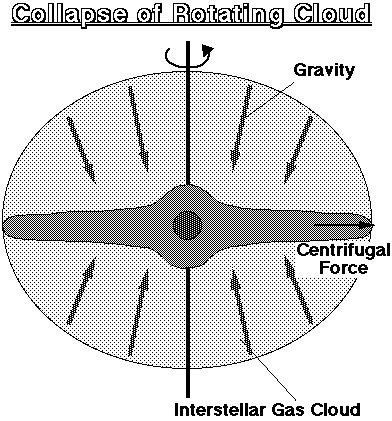
3. Mature stars
| Masses | 0.1 | to | 60 | solar masses | |||||
| Luminosities | 10-3 | to | 106 | solar luminosities | |||||
| Smaller | --> not enough central pressure to ignite Fusion | ||||||||
| Brown Dwarfs | may contribute to dark matter in universe | ||||||||
| Larger | --> higher radiation pressure than gravity | ||||||||
| Fly apart | Eddington Limit of stars | ||||||||
B) Basic model of stars (like sun)
| Interior: | pressure, density, temperature increase inwards | |
| but gravity balanced by pressure from hot (burning) core | ||
| maintains burn rate | --> star's thermostat | |
| More massive star | --> higher central pressure | --> hotter, denser --> | ||
| more fusion | --> more luminosity | --> fuel used faster --> shorter life | ||
a) H core "burns" first = Main Sequence:
Star on main sequence for long time (lots of hydrogen)
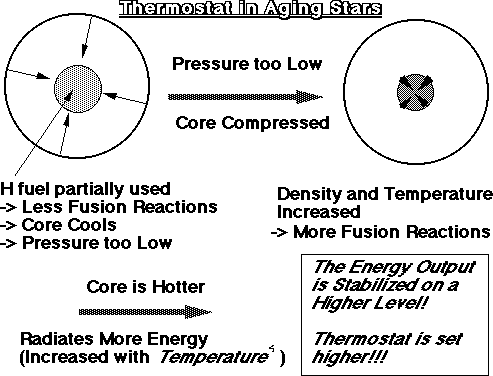
b) Core compression:
| Pressure goes as | (particles per volume) x temperature | |||
| Fusion removes particles with time | ||||
| Þ Volume must decrease (compression) | ||||
| --> temperature and density increase | ||||
| --> more fusion | Þ more luminosity | |||
"Early Sun Paradox": the sun was much dimmer when life began
| Possible answer(?): more carbon dioxide | --> stronger greenhouse effect | |
| --> helped keep early Earth warm |
a) He core (no fusion), H-"burning" shell
| He core shrinks to maintain pressure and drags down overlying H | ||
| Overlying H starts "burning" on an overheated oven | ||
| Luminosity increases: | --> red giant | |
| Surface expands and cools | --> red | |
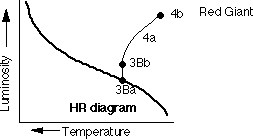
b) Degenerate He core
| Electrons can't be packed closer | --> (huge) "Degeneracy Pressure" | ||
| rising temperature does not increase pressure | |||
| --> thermostat does not work | --> He fuses in flash | ||
then a lot of heat overcomes problem
c) He core fusion Þ C, O
| Luminosity decreases | --> Surface shrinks and warms up |
d) C, O core
| He core burnt out | --> He shell burning (similar to 2a) |
| e) Heavy elements made up to Fe | (Fowler: Nobel Prize) | ||||
| But: | Heavier than Fe requires energy | ||||
| Fe nucleus + (something) | --> more mass than sum of parts | ||||
| Requires energy to be converted into mass; from gravity | |||||
f.) No more fuel
| Radiation balanced by loss of gravitational energy | |||||
| --> contraction --> hotter | |||||
| But: | only up to when the electrons cannot compressed any further | ||||
| Degeneracy Pressure as under 2b | |||||
Tests of the star model
| - Temp - luminosity relation (the HR diagram) | |
| - Mass-luminosity relation | |
| - Abundances of heavy elements | |
| - Star Tracks (clusters = same age stars) |
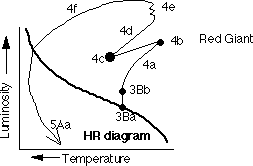
5. Star deaths
a) White Dwarf is their corpse
| --> "electron degeneracy" | --> huge pressure |
| M < 1.4 Msun (Chandrasekhar: Nobel Prize) |
b) Mass loss
| via stellar winds | and/or | |
| pulsed ejection | --> planetary nebulae | |
| --> recycling |
a) Novae:
| White Dwarf gains mass (Hydrogen) from other star | ||
| --> explosive (degeneracy) fusion on surface (high temp & pressure) |
b) Type I Supernova
| an example of mass transfer in a binary star system | |||||||
| White Dwarf + more mass --> shrinks --> hotter interior | |||||||
| Collapse when M >1.4 MS | |||||||
| --> sudden flash of fusion (very rapid due to degeneracy) | |||||||
| --> White Dwarf explodes | --> recycling | ||||||
| Type I Supernovae have all the same luminosity | |||||||
| --> excellent bright Standard Candle | |||||||
a) Type II Supernova Process
| Heavy star with degenerate iron core (no more fuel) (see 2f) | ||||
| Fe core gains mass from overlying layers to > 1.4 Msun | ||||
| --> electron degeneracy pressure fails | ||||
| --> collapse | --> neutron star core or black hole core | |||
| 'Rebound' of falling material on core and neutrinos from core | ||||
| --> expulsion of outer 80% of star | ||||
Energy source = gravity
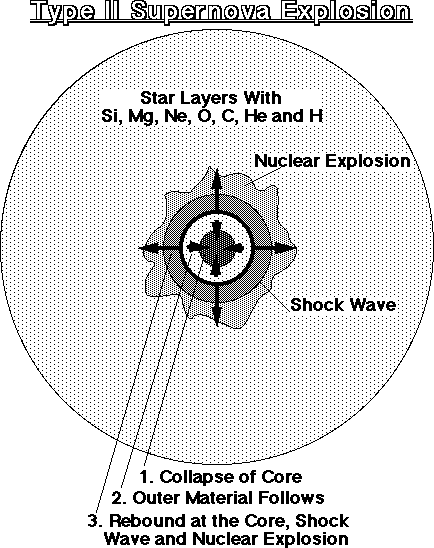
| Theory | --> Type II SN's come from massive supergiants | |||
| SN 1987: | a massive supergiant disappeared | |||
b) Consequences of SN
| Remnants: | - Expanding hot nebula | ||||||
| some only visible with X-ray telescopes, only now discovered | |||||||
| - High-energy electrons (cosmic rays) | |||||||
| - Neutron star or black hole | |||||||
| Importance of SN's: | |||||||
| i. Neutrino astronomy | |||||||
| 1987 SN: neutrinos | Þ proof of neutron star formation | ||||||
| neutrinos arrived before light | --> action was in the star's core | ||||||
| all neutrinos arrived at same time | --> upper limit on neutrino mass | ||||||
| ii. Make elements heavier than Fe: | |||||||
| Fe nucleus + (something) | --> more mass than sum of parts | ||||||
| Requires energy to be converted into mass; from gravity | |||||||
| 1987 SN: gamma rays from radioactive cobalt | |||||||
| --> proof of heavy element formation | |||||||
| iii. Recycling of material (we are made of 'star stuff') | |||||||
| iv. Produce shocks = denser, higher pressure gas | |||||||
| v. Shocks initiate star formation "Life Cycle of Stars" | |||||||

| Density increases | --> more self-gravity | |||
| Solar system formation triggered?? | ||||
| vi. Shocks --> cosmic rays via repeated bounces off converging "mirrors" | ||||
| like at shocks in the solar wind (see IX.1.) | ||||
c) End products
| e + p + squeeze | --> neutron + neutrino (most of SN energy) | ||
| stable by Neutron degeneracy pressure if M < 3(?) Msun | |||
| 1 sugarcube of Neutron star material = 1 billion tons (Mt. Washington) | |||
| Observation: Pulsars | rapidly pulsating radio sources (Hewish: Nobel Prize) | |||||
| --> Rotating neutron stars with strong magnetism | ||||||
| Analogy: | a lighthouse | |||||
| conservation of angular momentum | --> rapid rotation after collapse | |||||
| compression of magnetic lines | --> strong magnetism | |||||
| strong magnetism | --> synchrotron radiation | |||||
Importance of pulsars:
| i. Proves neutron stars exist | |||||
| ii. Found in SN remnants: | Proves Type II SN scenario | ||||
| iii. Energize SN remnants (e.g. synchrotron from Crab Nebula) | |||||
| Hypothesis: | Rotational energy from the pulsar powers the Crab Nebula | ||||
| Prediction: | The pulsar should gradually rotate more slowly | ||||
| Test: | It slows down at just the right rate | ||||
| iv. Tell us where SN's have occurred: Globular clusters have had | |||||
| many SN's which may have ejected stars from the clusters | |||||
| v. Precise clocks in space: | |||||
| e.g. Doppler effect | --> the "new planet" around a pulsar | ||||
| e.g. used to study interstellar plasma | |||||
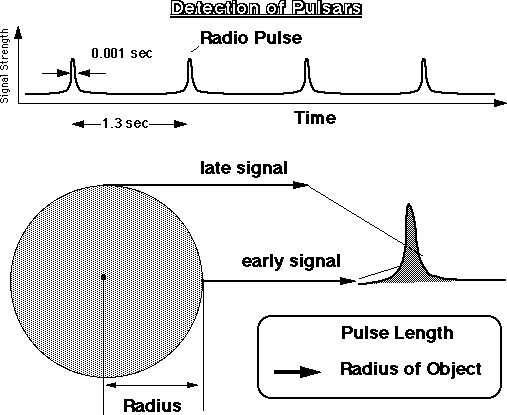
d) Binary X-ray sources:
Examples of mass transfer:
| Mass from normal star onto compact object | --> compression | |||
| --> enormous heating | --> X-rays (and gamma rays) | |||
| Determine mass of neutron star (black hole) | Kepler's 3rd Law |
Very strong gravity on surface of Neutron star
| escape velocity > 0.5 speed of light | --> special considerations |
D) Life of stars with different masses
| Low mass (< 0.4 Ms) | H burn | White Dwarf | |||
| Medium mass (~ 0.4 - 3) | H burn | Red Giant | Mass Loss | White Dwarf | |
| High mass (~ 3 - 8) | H burn | Red Giant | Supernova | Neutron Star | |
| Very high mass (> 8) | H burn | Red Giant | Supernova | Black Hole? | |